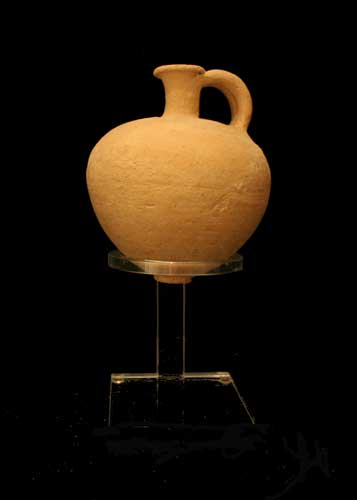Middle Bronze Age Terracotta Juglet, 1900 BCE - 1600 BCE
Terracotta
5
SP.284
In Israel, as in other ancient nations, it was customary to dedicate persons or objects to sacred use by anointing them with oil. Thus Samuel anointed Saul king, as Moses...
In Israel, as in other ancient nations, it was customary to dedicate persons or objects to sacred use by anointing them with oil. Thus Samuel anointed Saul king, as Moses had hallowed the tabernacle and Aaron the high priest before, and Abraham had sanctified Isaac.
Created just prior to the time of the Hebrew patriarchs, this vessel might have held oil used for anointing people in religious ceremonies, and it was perhaps from a jug similar to this that Abraham would later anoint Isaac in the moment before the angel appeared. Or perhaps it held perfume, purchased as a gift by a loving husband for his wife. It may have even served as a table vessel intended for daily usage, and held oil that would adorn the meal of a simple shepherd or a carpenter, such as Jesus of Nazareth.
As we hold it in our hands today, admiring its simple beauty, we are aware of the touch of other hands long ago. Who might have held it when it was new? Were the dreams and emotions that guided their lives so very different from our own? The vessel's graceful unadorned shape appeals as much to the contemporary eye as it did to the culture that created it. Such artifacts, ordinary enough in their own age, connect us in an intimate way with the world of the past. In its presence, the centuries melt away and the imagination sets out on a journey of discovery.
Created just prior to the time of the Hebrew patriarchs, this vessel might have held oil used for anointing people in religious ceremonies, and it was perhaps from a jug similar to this that Abraham would later anoint Isaac in the moment before the angel appeared. Or perhaps it held perfume, purchased as a gift by a loving husband for his wife. It may have even served as a table vessel intended for daily usage, and held oil that would adorn the meal of a simple shepherd or a carpenter, such as Jesus of Nazareth.
As we hold it in our hands today, admiring its simple beauty, we are aware of the touch of other hands long ago. Who might have held it when it was new? Were the dreams and emotions that guided their lives so very different from our own? The vessel's graceful unadorned shape appeals as much to the contemporary eye as it did to the culture that created it. Such artifacts, ordinary enough in their own age, connect us in an intimate way with the world of the past. In its presence, the centuries melt away and the imagination sets out on a journey of discovery.



